Influence of Grid Resolution in Modeling of Air Pollution from Open Burning
Abstract
:1. Introduction
2. Materials and Methods
2.1. CALPUFF Modeling System
2.2. Study Area
2.3. Emission Data
2.4. Model Configuration
2.5. Comparative Analysis of Different Computational Grid Resolutions Using Statistical Indicators
3. Results
4. Conclusions
Acknowledgments
Author Contributions
Conflicts of Interest
Abbreviations
| VOC | Volatile Organic Compound |
| CALMET | California Puff Mesoscale Diagnostic 3-Dimensional Meteorological Model |
| CALPOST | California Puff Mesoscale Post-Processing Program |
| CALPUFF | California Puff Mesoscale Dispersion Model |
| GIS | Geographic Information System |
| U.S. EPA | the United States Environmental Protection Agency |
| SRTM | the Shuttle Radar Topography Mission |
| GLCC | the Global Land Cover Characterization |
| WRF | the Weather Research and Forecasting |
| FB | Fractional Bias Geometric |
| MG | Mean Bias |
| NMSE | Normalized Mean Square Error |
| VG | Geometric Variance |
| R | Correlation Coefficient |
| FAC2 | Fraction of predictions within a factor of two of observations |
| HR-RADM | High-resolution version of the regional acid deposition model |
| CTM | Chemical Transport Model |
| PMCAMx | Particulate Matter Comprehensive Air quality Model with extensions |
| CMAQ | Community Multiscale Air Quality |
References
- Zhang, H.; Ye, X.; Cheng, T.; Chen, J.; Yang, X.; Wang, L.; Zhang, R.A. Laboratory study of agricultural crop residue combustion in China: Emission factors and emission inventory. Atmos. Environ. 2008, 42, 8432–8441. [Google Scholar] [CrossRef]
- Yuan, B.; Liu, Y.; Shao, M.; Lu, S.; Streets, D.G. Biomass burning contributions to ambient VOCs species at a receptor site in the Pearl River delta (PRD), China. Environ. Sci. Technol. 2010, 44, 4577–4582. [Google Scholar] [CrossRef] [PubMed]
- Sornpoon, W.; Bonnet, S.; Kasemsap, P.; Prasertsak, P.; Garivait, S. Estimation of emissions from sugarcane field burning in Thailand using bottom-up country-specific activity data. Atmosphere 2014, 5, 669–685. [Google Scholar] [CrossRef]
- Wang, H.; Lou, S.; Huang, C.; Qiao, L.; Tang, X.; Chen, C.; Zeng, L.; Wang, Q.; Zhou, M.; Lu, S.; et al. Source profiles of volatile organic compounds from biomass burning in Yangtze River Delta, China. J. Aerosol Air Qual. Res. 2014, 14, 818–828. [Google Scholar] [CrossRef]
- U.S. Environmental Protection Agency (U.S. EPA). Air Toxics Web Site—Health Effects Notebook for Hazardous Air Pollutants. Available online: http://www3.epa.gov/ttn/atw/hlthef/hapindex.html (accessed on 5 April 2015).
- Warneke, C.; Roberts, J.M.; Veres, P.; Gilman, J.; Kuster, W.C.; Burling, I.; Yokelson, R.; de Gouw, J.A. VOC identification and inter-comparison from laboratory biomass burning using PTR-MS and PIT-MS. Int. J. Mass. Spec. 2011, 303, 6–14. [Google Scholar] [CrossRef]
- Office of Agricultural Economics (OAE). Available online: http://www.oae.go.th/download/prcai/Dry Crop/maize.pdf (accessed on 6 April 2015).
- Department of Disease Control (DDC). Annual Epidemiological Surveillance Report Upper North of Thailand during Haze Problem Period (January–April, 2014). Available online: http://dpc10.ddc.moph.go.th/epidpc10/download.php?file=17_1.pdf&loc=major&type=load (accessed on 11 January 2015).
- U.S. Environmental Protection Agency (U.S. EPA). Preferred/Recommended Models: CALPUFF Modeling System. Available online: http://www.epa.gov/scram001/dispersion_prefrec.htm (accessed on 8 January 2015).
- Li, Y.; Henze, D.K.; Jack, D.; Kinney, P.L. The influence of air quality model resolution on health impact assessment for fine particulate matter and its components. Air Qual. Atmos. Health 2016, 9, 51–68. [Google Scholar] [CrossRef]
- Ghannam, K.; El-Fadel, M. Emissions characterization and regulatory compliance at an industrial. Atmos. Environ. 2013, 69, 156–169. [Google Scholar] [CrossRef]
- Punger, E.M.; West, J.J. The effect of grid resolution on estimates of the burden of ozone and fine particulate matter on premature mortality in the USA. Air Qual. Atmos. Health 2013, 6, 563–573. [Google Scholar] [CrossRef] [PubMed]
- Vaidyanathan, A.; Dimmick, W.F.; Kegler, S.R.; Qualters, J.R. Statistical air quality predictions for public health surveillance: evaluation and generation of county level metrics of PM2.5 for the environmental public health tracking network. Int. J. Health Geogr. 2013, 12. [Google Scholar] [CrossRef] [PubMed]
- Jang, J.-C.C.; Jeffries, H.E.; Byun, D.; Pleim, J.E. Sensitivity of ozone to model grid resolution—I. Application of high-resolution regional acid deposition model. Atmos. Environ. 1995, 29, 3085–3100. [Google Scholar] [CrossRef]
- Fountoukis, C.; Koraj, D.; Denier van der Gon, H.A.C.; Charalampidis, P.E.; Pilinis, C.; Pandis, S.N. Impact of grid resolution on the predicted fine PM by a regional 3-D chemical transport model. Atmos. Environ. 2013, 68, 24–32. [Google Scholar] [CrossRef]
- Shrestha, K.L.; Kondo, A.; Kaga, A.; Inoue, Y. High-resolution modeling and evaluation of ozone air quality of Osaka using MM5-CMAQ system. J. Environ. Sci. 2009, 21, 782–789. [Google Scholar] [CrossRef]
- Tan, J.; Zhang, Y.; Ma, W.; Yu, Q.; Wang, J.; Chen, L. Impact of spatial resolution on air quality simulation: A case study in a highly industrialized area in Shanghai, China. Atmos. Pollut. Res. 2015, 6, 322–333. [Google Scholar] [CrossRef]
- Garcia-Menendez, F.; Odman, M.T. Adaptive grid use in air quality modeling. Atmosphere 2011, 2, 484–509. [Google Scholar] [CrossRef]
- Scire, J.S.; Strimaitis, D.G.; Yamartino, R.J. A User’s Guide for the CALPUFF Dispersion Model (Version 5.0). Available online: http://www.src.com (accessed on 15 December 2014).
- Jittra, N.; Thepanondh, S. Performance evaluation of AERMOD and CALPUFF air dispersion models in industrial complex area. Air Soil. Water Res. 2015, 8, 87–95. [Google Scholar]
- Thepanondh, S.; Outapa, P.; Saikomol, S. Evaluation of dispersion model performance in predicting SO2 concentrations from petroleum refinery complex. Int. J. Geomate 2016, 11, 2129–2135. [Google Scholar] [CrossRef]
- Tartakovsky, D.; Stern, E.; Broday, D.M. Dispersion of TSP and PM10 emissions from quarries in complex terrain. Sci. Total. Environ. 2016, 542, 946–954. [Google Scholar] [CrossRef] [PubMed]
- Lakes Environmental Software. CALPUFF View. Available online: http://www.weblakes.com/products/calpuff/resources/lakes_calpuff_view_brochure.pdf (accessed on 24 January 2015).
- Huang, X.; Song, Y.; Li, M.; Li, J.; Zhu, T. Harvest season, high polluted season in East China. Environ. Res. Lett. 2012, 7, 044033. [Google Scholar] [CrossRef]
- Thepanondh, S. Research Project on Development of Thailand’s Assimilative Capacity-Based Air Emission Map: Case of Sulfur Dioxide and Nitrogen Dioxide (Thailand); National Research Council of Thailand: Bangkok, Thailand, 2012. [Google Scholar]
- Department of National Parks, Wildlife and Plant Conservation (DNP). Hotspot Information in Thailand; Ministry of Natural Resources and Environment: Bangkok, Thailand, 2015.
- Chang, J.C.; Hanna, S.R. Technical Descriptions and User′s Guide for the BOOT Statistical Model Evaluation Software Package, 2nd ed; Hindawi Publishing Corporation: Cairo, Egypt, 2005. [Google Scholar]
- Lee, H.D.; Yoo, J.W.; Kang, M.K.; Kang, J.S.; Jung, J.H.; Oh, K.J. Evaluation of concentrations and source contribution of PM-10 and SO2 emitted from industrial complexes in Ulsan, Korea: Interfacing of the WRF-CALPUFF modeling tools. Atmos. Pollut. Res. 2014, 5, 664–676. [Google Scholar] [CrossRef]
- Patryla, L.; Galeriua, D. Statistical Performances Measures—Models Comparison. Available online: http://www-ns.iaea.org/downloads/rw/projects/emras/emras-two/first-technical-meeting/sixth-working-group-meeting/working-group-presentations/workgroup-7-presentations/presentation-6th-wg7-statistical-performances.pdf (accessed on 13 May 2015).
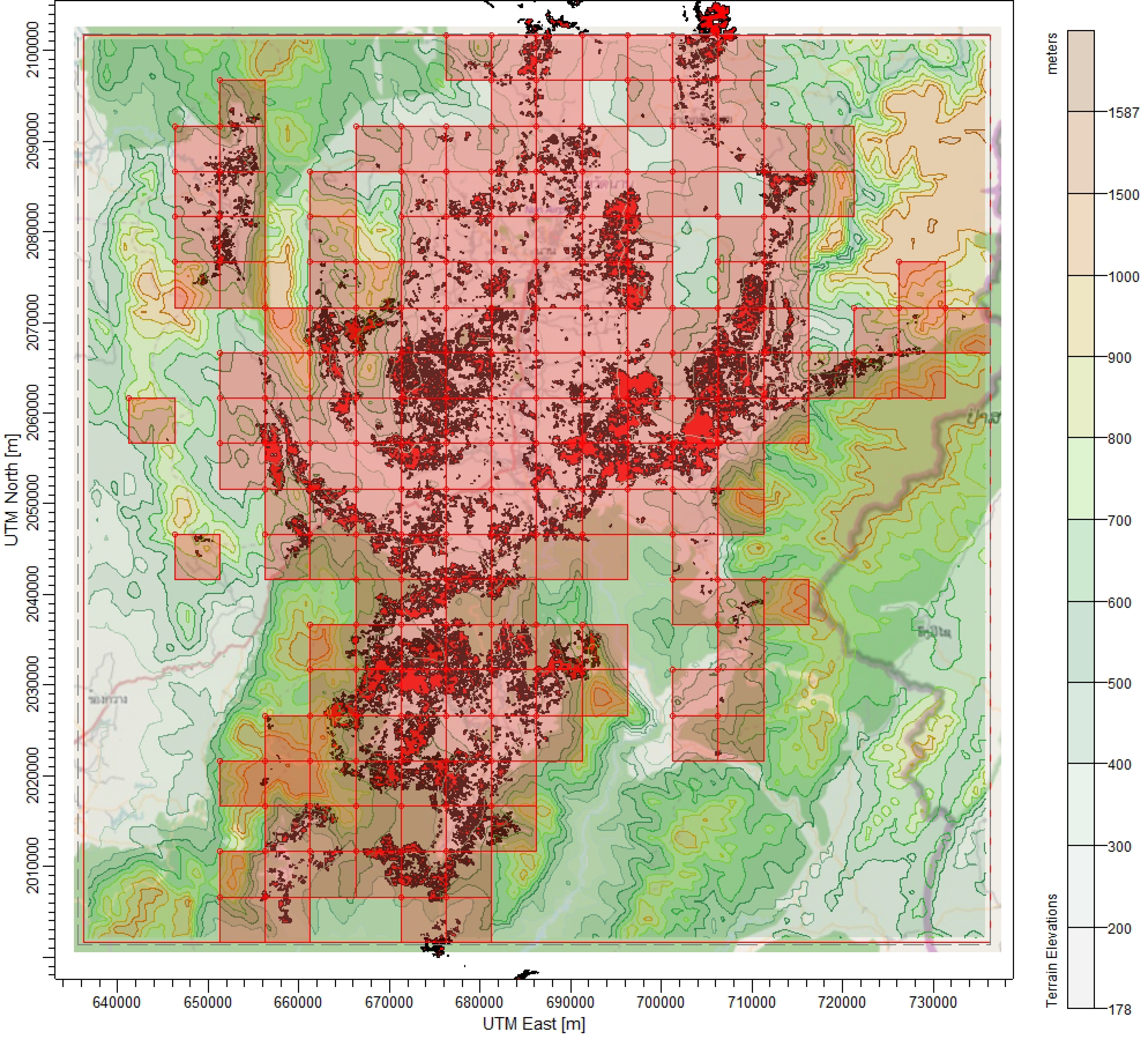
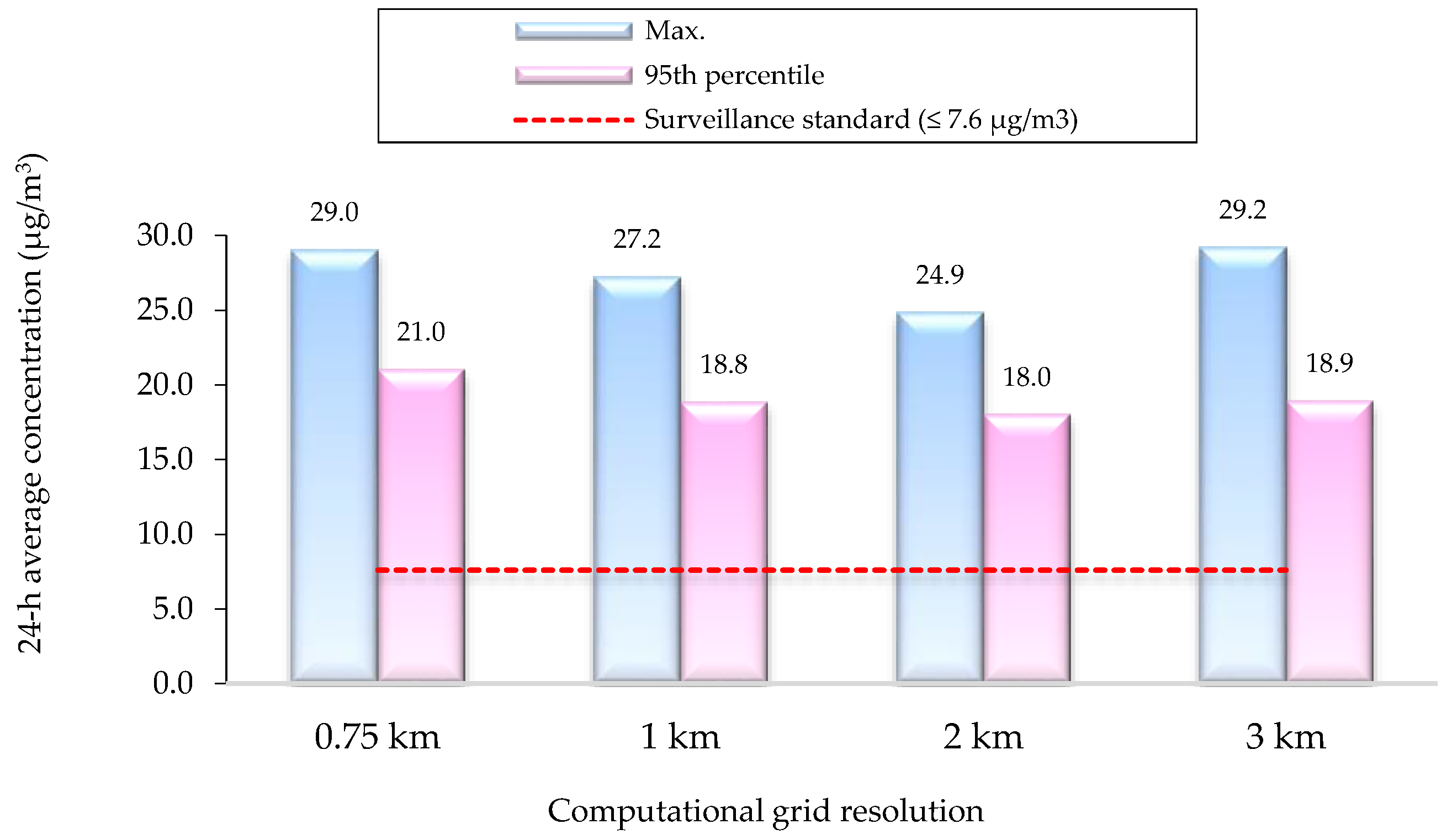
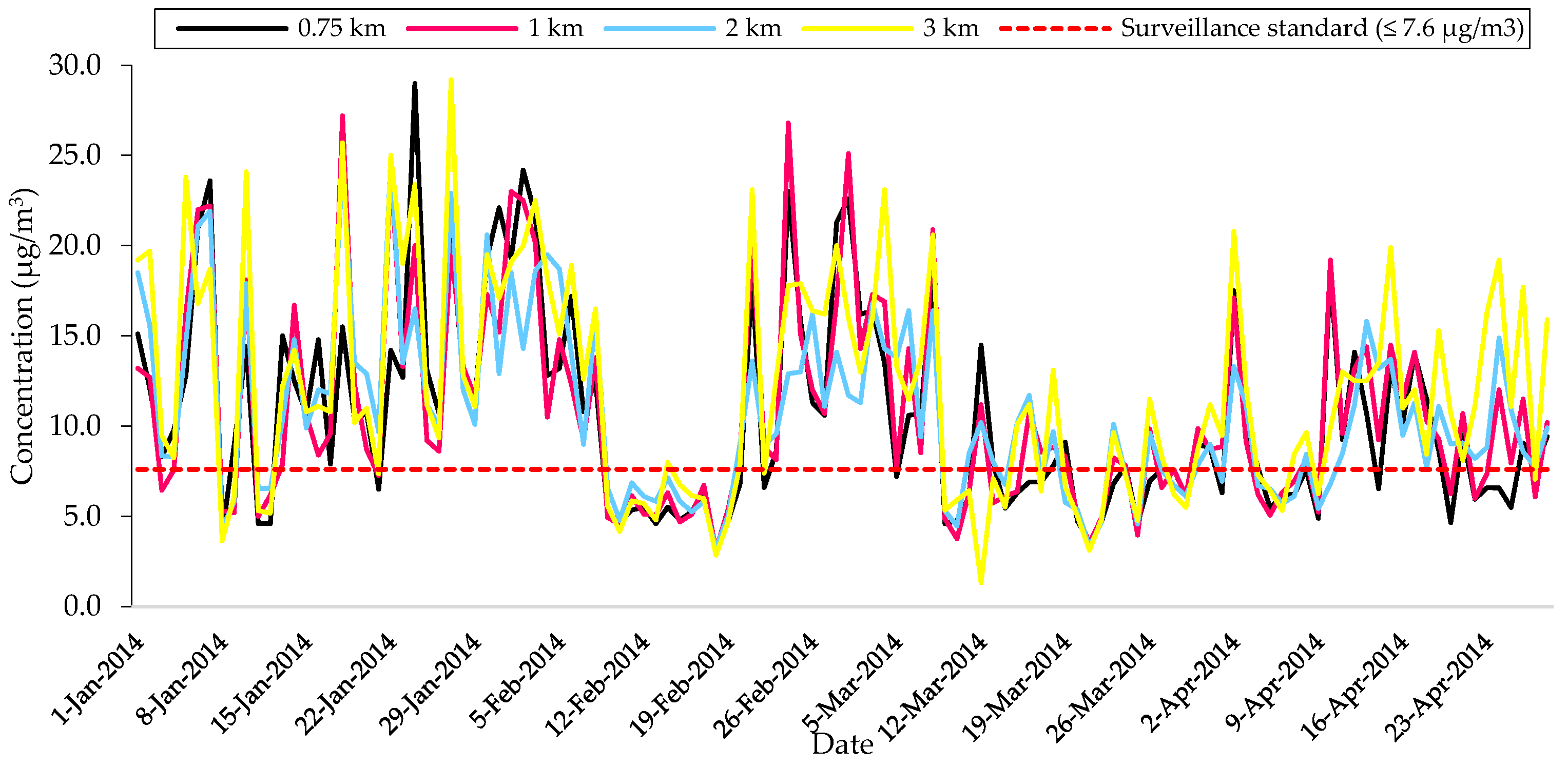
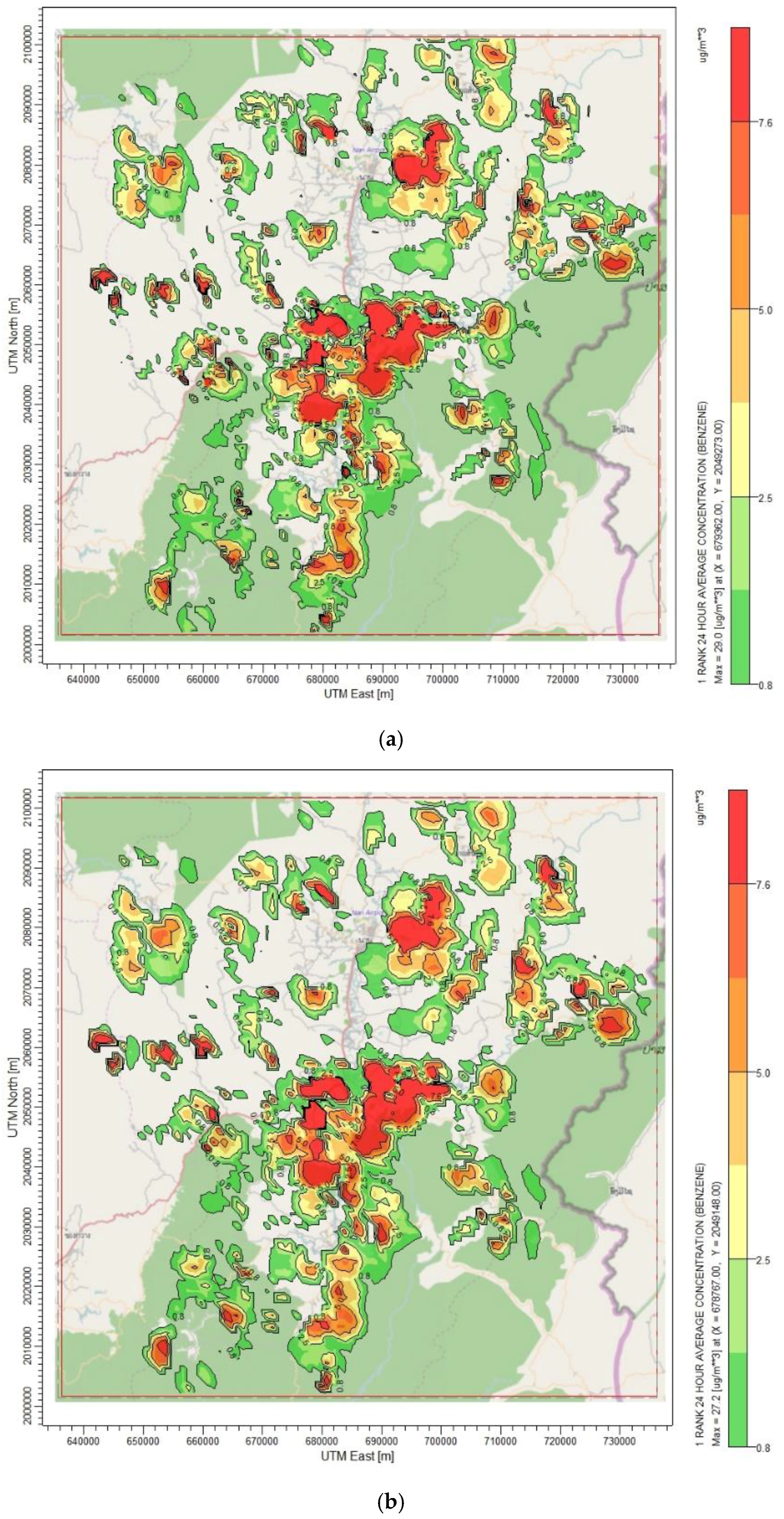
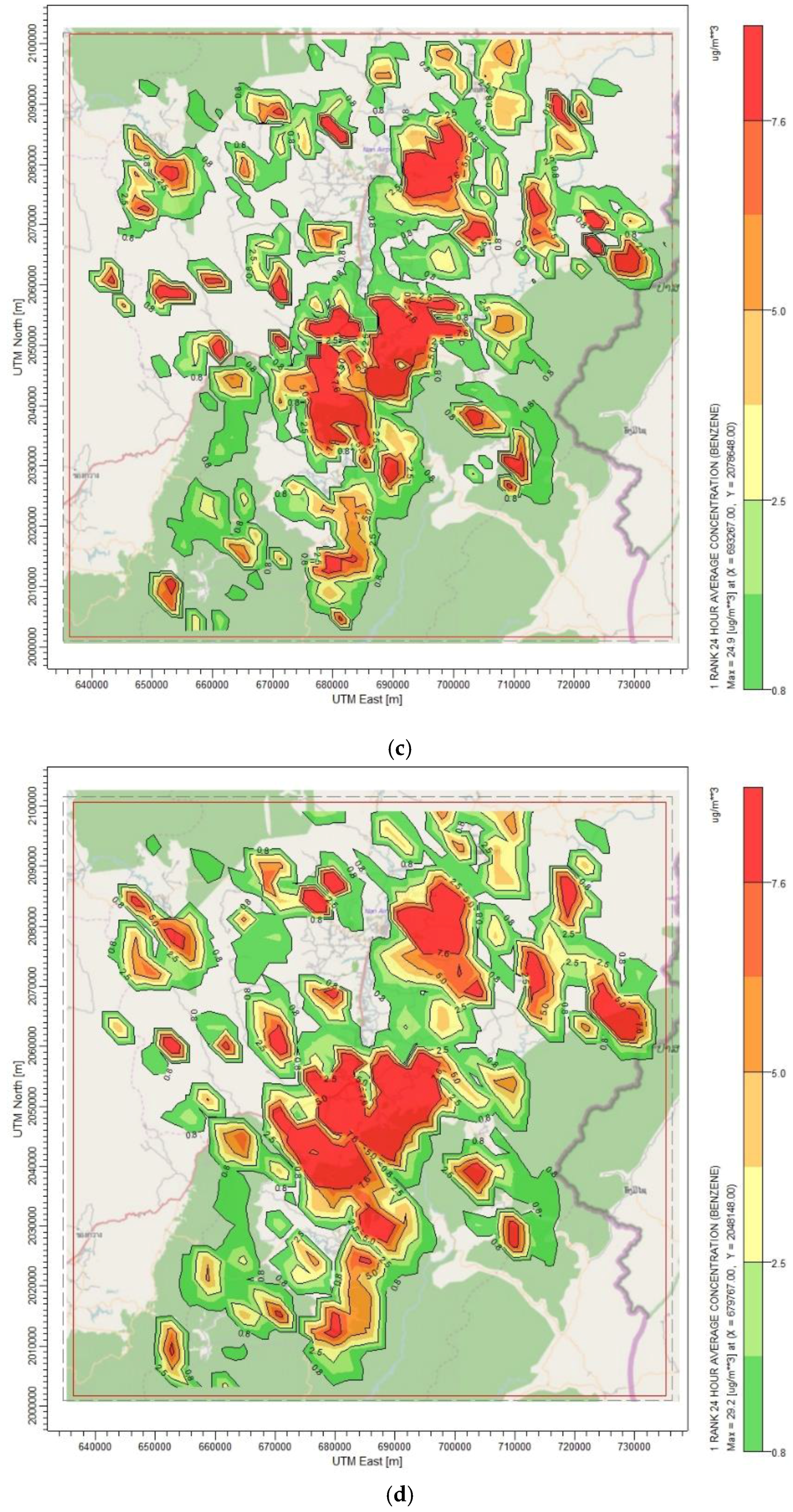
| Model | Computational Time (min) | |||
|---|---|---|---|---|
| 0.75 km | 1 km | 2 km | 3 km | |
| CALMET | 72 | 26 | 7 | 2 |
| CALPUFF | 2284 | 775 | 60 | 5 |
| Total | 2356 | 801 | 67 | 7 |
| Statistical Indicator | Computational Grid Resolution | Ideal Value | Acceptable Value [27] | ||
|---|---|---|---|---|---|
| P1 (0.75 km vs. 1 km) | P2 (0.75 km vs. 2 km) | P3 (0.75 km vs. 3 km) | |||
| 1.1 | 1.1 | 1.1 | |||
| 1.2 | 1.6 | 1.8 | |||
| 2.1 | 2.1 | 2.1 | |||
| 2.5 | 3.0 | 3.6 | |||
| FB | −0.1 | −0.4 | −0.5 | 0.0 | −0.3 < FB < 0.3 |
| MG | 1.0 | 0.7 | 0.7 | 1.0 | 0.7 < MG < 1.3 |
| NMSE | 0.7 | 1.4 | 2.4 | 0.0 | NMSE < 4.0 |
| VG | 1.1 | 1.5 | 2.1 | 1.0 | VG < 1.6 |
| R | 0.9 | 0.9 | 0.9 | 1.0 | |
| FAC2 | 1.1 | 1.7 | 2.0 | 1.0 | 0.5 ≤ FAC ≤ 2.0 |
© 2016 by the authors; licensee MDPI, Basel, Switzerland. This article is an open access article distributed under the terms and conditions of the Creative Commons Attribution (CC-BY) license (http://creativecommons.org/licenses/by/4.0/).
Share and Cite
Sirithian, D.; Thepanondh, S. Influence of Grid Resolution in Modeling of Air Pollution from Open Burning. Atmosphere 2016, 7, 93. https://doi.org/10.3390/atmos7070093
Sirithian D, Thepanondh S. Influence of Grid Resolution in Modeling of Air Pollution from Open Burning. Atmosphere. 2016; 7(7):93. https://doi.org/10.3390/atmos7070093
Chicago/Turabian StyleSirithian, Duanpen, and Sarawut Thepanondh. 2016. "Influence of Grid Resolution in Modeling of Air Pollution from Open Burning" Atmosphere 7, no. 7: 93. https://doi.org/10.3390/atmos7070093
APA StyleSirithian, D., & Thepanondh, S. (2016). Influence of Grid Resolution in Modeling of Air Pollution from Open Burning. Atmosphere, 7(7), 93. https://doi.org/10.3390/atmos7070093






